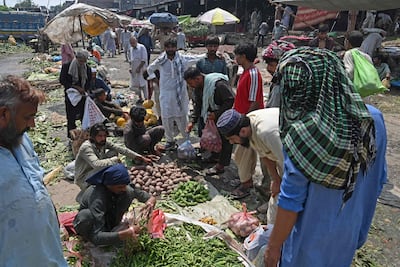Fruit and vegetable prices have shot up across Pakistan after flooding destroyed crops and disrupted supplies.
Flash floods have washed away roads, buildings and bridges, killing at least 1,100 people so far in the country’s worst flooding in three decades.
Damage to homes and infrastructure could cost more than $10 billion, the country's planning minister said on Monday. Losses to the country's key farming sector have yet to be fully assessed.
In the eastern city of Lahore, close to the border with India and far from the worst floods in Sindh province, the prices of some vegetables have tripled.
The Pakistani government sets prices for some fresh produce — but traders often ignore them.
“Last week, I sold onions for 90 rupees a kilogram and today the government price is 300 per kg,” said vegetable seller Ahmad Ali.
Tens of thousands of tonnes of tomatoes and onions, among the most common ingredients in Pakistani cooking, are consumed each month.
“The supply of vegetables and fruit to Lahore is getting lower day by day because of the flood, rains and destruction to roads,” said Malik Awan, a supplier at Lahore's fruit and vegetable market.

“Before the current scenario, we were receiving over 100 trucks [of fresh produce] daily. Now, we receive 10 to 15 trucks only,” Awan said.
Pakistan's 220 million people are already facing rising inflation, with consumer prices up about 25 per cent annually in July.
The economy is in turmoil, with fast-depleting foreign reserves and a record depreciation of the rupee against the US dollar.
Officials said that more than 800,000 hectares of agricultural land had been flooded, destroying most standing crops and preventing farmers from planting anew.
Hundreds of kilometres from Lahore, people must clear up flooded homes and, at the same time, worry about where the next meal will come from.
“Tomatoes were 60 rupees a kg, and now they are more than 200 … even the price of flour is double now,” said Sain Husain, 20, whose home in the village of Garhi Yasin, in the southern province of Sindh, has been badly damaged. “What can we do?”
Sindh, with a population of 50 million, is the hardest hit, with 697 millimetres of rain so far in the monsoon period, about 466 per cent above the 30-year monsoon average. Pakistan, as a whole, has received about 190 per cent more rain than the 30-year average.
In Dera Ismail Khan, which lies along the Indus river in central Pakistan, warehouses storing vegetables are already emptying out.
The government of Prime Minister Shehbaz Sharif is scrambling to secure supplies.
“The rice crop has been washed away,” Mr Sharif told reporters after visiting northern Pakistan. “Fruit and vegetables are gone.” He said floodwaters had swept away 700,000 livestock.
Pakistan's agriculture sector accounts for more than a fifth of the country's economic output, employing up to 40 per cent of the workforce and producing goods worth about $80 billion annually.
Commerce Minister Naveed Qamar said on Wednesday that the government was close to an agreement to import vegetables and other edible goods from Iran and Afghanistan. He said an urgent request had gone to the Cabinet to approve it.
“Prices are up already. If you go to buy onions, you wouldn't get [them]. If you go to buy tomatoes, you will get [them] at a much higher price,” Mr Qamar told a news conference.























